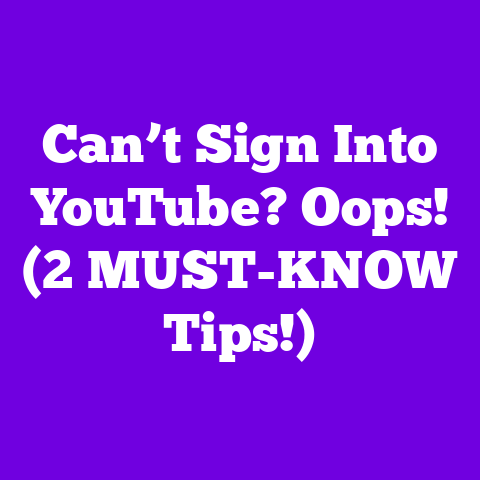Automatically Transcribe Youtube Video (5 Tips!)
I’m seeing a huge shift towards accessibility, and frankly, it’s awesome.
But it’s also smart business.
Think about it: more viewers, better engagement, and a bigger impact.
So, let’s dive into how you can leverage automatic transcription to level up your YouTube game.
Section 1: The Importance of Video Transcription
Why should you care about transcribing your videos?
It’s not just a nice-to-have; it’s becoming a must-have.
Subsection 1.1: Accessibility for All
Imagine creating content that everyone can enjoy.
Transcription makes that a reality.
It opens your videos to viewers who are hearing-impaired, deaf or hard-of-hearing, or who are non-native speakers.
Think about the global audience you’re missing out on if your content isn’t accessible!
According to the World Health Organization, over 5% of the world’s population – 430 million people – require rehabilitation to address their ‘disabling’ hearing loss.
That’s a massive potential audience you could be reaching!
By providing transcriptions, you’re not just being inclusive; you’re expanding your reach exponentially.
Subsection 1.2: SEO Benefits
Let’s talk SEO.
You know how important it is to get your videos seen.
Well, transcriptions are like a secret weapon.
YouTube’s search algorithms can’t “watch” your videos, but they can read the text.
By providing a transcript, you’re giving the algorithm a roadmap to understand what your video is about.
Think of it this way: all those keywords you’re trying to rank for?
They’re now searchable within your video.
This significantly boosts your video’s discoverability.
For instance, if you’re doing a tutorial on “best camera lenses for vlogging,” having that phrase repeatedly in your transcript strengthens your ranking for that search term.
Subsection 1.3: Enhancing Viewership and Engagement
Have you ever been in a situation where you can’t listen to a video but want to know what it’s about?
I know I have!
Transcriptions solve that problem.
Viewers can quickly scan the text to see if the content is relevant to them.
This increases the likelihood of them watching the whole thing.
Plus, some viewers simply prefer to read along while they watch.
It helps them retain information better.
In a study by PLOS One, research showed that reading captions significantly improved recall and comprehension.
Providing that option can lead to longer watch times and increased engagement.
Section 2: Understanding Automatic Transcription Tools
Okay, so you’re convinced about the importance of transcription.
But how do you actually do it without spending hours manually typing everything out?
That’s where automatic transcription tools come in.
Subsection 2.1: Overview of Current Technologies
By 2025, automatic transcription technology will be even more advanced than it is today.
We’re talking about AI-powered tools that leverage machine learning to accurately convert speech to text.
These tools analyze audio waveforms, identify phonemes, and use natural language processing (NLP) to create coherent transcripts.
Some tools even offer features like speaker identification, punctuation correction, and the ability to handle multiple languages.
The advancements in AI are making these tools incredibly powerful and user-friendly.
Subsection 2.2: Comparing Popular Transcription Services
Let’s look at some popular options.
While I can’t predict exactly what the landscape will look like in 2025, I can extrapolate based on current trends.
Here are a few services that I expect will still be leading the pack, or whose advancements will lead to new, better tools:
- Otter.ai: Known for its accuracy and real-time transcription capabilities.
Great for transcribing live streams or webinars. - Descript: A powerful tool that combines transcription with audio and video editing.
Perfect for creators who want to streamline their workflow. - Google Cloud Speech-to-Text: A robust option for those who need enterprise-level accuracy and scalability.
- Happy Scribe: A popular choice for multilingual transcription, offering support for a wide range of languages.
- Trint: This service offers a good balance of accuracy, speed, and affordability.
When choosing a tool, consider factors like:
- Accuracy: How well does it transcribe speech, especially with accents or background noise?
- Cost: What’s the pricing model? Is it pay-per-minute or a monthly subscription?
- User-friendliness: How easy is it to upload videos, edit transcripts, and export files?
- Language support: Does it support the languages you need?
- Integration with YouTube: Can you easily upload transcripts to your videos?
Section 3: 5 Essential Tips for Automatically Transcribing YouTube Videos
Now, let’s get down to the nitty-gritty.
Here are five essential tips for making the most of automatic transcription in 2025:
Tip 1: Choose the Right Transcription Tool
This might seem obvious, but it’s crucial.
Don’t just pick the first tool you find.
Take the time to research and compare different options.
Consider your specific needs and budget.
Do you need multilingual support?
Do you need advanced editing features?
Look for tools that offer free trials or demos so you can test them out before committing.
Read reviews and see what other YouTubers are saying.
Remember, the best tool for you is the one that fits your workflow and delivers the accuracy you need.
Tip 2: Optimize Audio Quality for Better Transcriptions
Garbage in, garbage out.
That old saying holds true for transcription.
The better your audio quality, the more accurate your transcriptions will be.
Invest in a good microphone.
Record in a quiet environment.
Avoid background noise.
Use audio editing software to clean up your audio before uploading it to the transcription tool.
Remove any hums, hisses, or pops.
The cleaner your audio, the better the AI can understand it.
Here are a few quick tips for optimizing audio:
- Use an external microphone: The built-in mic on your computer or phone isn’t going to cut it.
- Record in a quiet space: Find a room with minimal echo and background noise.
- Speak clearly and slowly: Enunciate your words and avoid mumbling.
- Use a pop filter: This will help reduce plosives (those harsh “p” and “b” sounds).
- Monitor your audio levels: Make sure your audio isn’t too loud or too quiet.
Tip 3: Edit and Review Transcriptions for Accuracy
Even the best automatic transcription tools aren’t perfect.
They can make mistakes, especially with technical terms, slang, or unusual accents.
That’s why it’s crucial to review and edit your transcriptions.
Don’t just blindly upload the automatically generated transcript.
Take the time to read through it carefully.
Correct any errors you find.
Add punctuation if necessary.
Break up long paragraphs into shorter ones.
Here’s a step-by-step guide to editing transcriptions:
- Read the entire transcript: Get a sense of the overall flow and identify any major errors.
- Listen to the video while reading the transcript: This will help you catch any subtle mistakes.
- Correct any errors: Fix typos, misspellings, and incorrect words.
- Add punctuation: Make sure the transcript is properly punctuated.
- Format the transcript: Break up long paragraphs and add headings or subheadings.
- Proofread the transcript: Give it one final read to catch any remaining errors.
Tip 4: Use Transcriptions for Content Repurposing
Transcriptions aren’t just for accessibility.
They can also be used to create additional content.
Think about it: you’ve already got a written version of your video.
Why not use it to create a blog post?
Or a social media snippet?
Or a newsletter?
Repurposing content is a great way to get more mileage out of your videos.
It also helps you reach a wider audience.
Some viewers prefer to read content rather than watch it.
By providing both options, you’re catering to different learning styles.
I’ve seen many successful YouTubers who have effectively repurposed their content.
For example, they might take a video tutorial and turn it into a step-by-step blog post with screenshots.
Or they might take a video interview and turn it into a series of social media quotes.
Tip 5: Promote Transcribed Content for Greater Reach
You’ve transcribed your video.
You’ve edited the transcript.
Now what?
Don’t just let it sit there!
Promote it!
Embed the transcript on your website or blog.
Share it on social media.
Use it to engage with your audience in different languages.
Here are a few ideas:
- Add the transcript to your video description on YouTube: This will make it easier for viewers to find and read.
- Create a blog post based on the transcript: This will help you attract more traffic to your website.
- Share snippets of the transcript on social media: This will help you promote your video and engage with your followers.
- Translate the transcript into other languages: This will help you reach a global audience.
Section 4: Future of Transcription in Video Content
What does the future hold for transcription in video content?
I believe we’re on the cusp of some exciting advancements.
Subsection 4.1: Trends to Watch in 2025 and Beyond
One trend to watch is real-time transcription.
Imagine being able to transcribe your videos live, as you’re recording them.
This would be a game-changer for live streamers and educators.
Another trend is AI improvements.
As AI continues to evolve, transcription accuracy will only get better.
We’ll see tools that can handle more complex audio, understand different accents, and even detect emotions.
These advancements will make transcription even more accessible and affordable.
It will become an essential part of every YouTuber’s workflow.
Subsection 4.2: The Role of Community Feedback
Don’t underestimate the power of your audience.
Encourage viewers to provide feedback on your transcriptions.
Ask them if they find them helpful.
Ask them if they notice any errors.
Use their feedback to improve your transcription process.
The more you engage with your audience, the better your content will become.
Consider creating a dedicated feedback form or using a comment section to gather input.
Conclusion
Adaptability is the name of the game in the ever-evolving world of YouTube.
Embrace automatic transcription as a vital tool for enhancing accessibility, boosting SEO, and engaging with your audience.
By following these five essential tips, you’ll be well on your way to creating content that resonates with viewers around the world.
So, go forth and transcribe!
Your audience (and your channel) will thank you for it.





